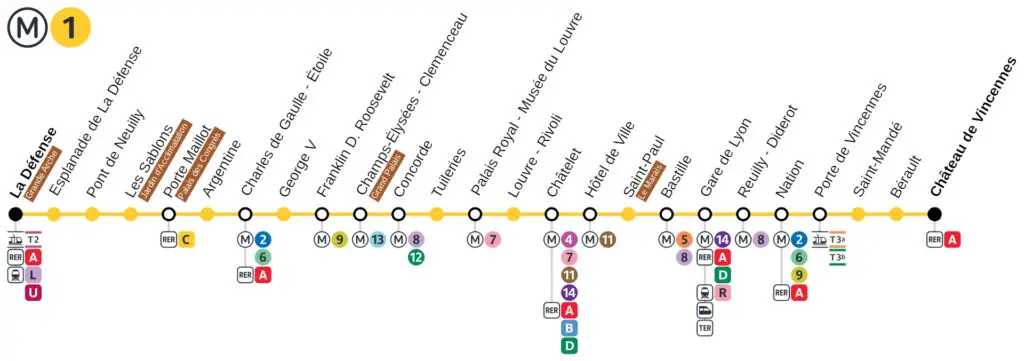Tuileries
City
Paris
Metro line
1

Tuileries metro station
The Tuileries metro station is located in Paris, France. It is in the city’s 1st arrondissement, near the Tuileries Gardens and the Louvre. The station is served by line 1 of the Paris metro.
The Tuileries metro station is popular with tourists and visitors alike, providing easy access to many of Paris’ major attractions. From the station, you can walk to sites such as the Louvre Museum, the Tuileries Gardens, Place de la Concorde and Avenue des Champs-Élysées.
Tuileries is a standard configuration station, with two platforms separated by the metro tracks. Established flush with the ground, the ceiling is made of a metal deck, whose silver-colored beams are supported by vertical pedestals. A 15-meter-long crypt, whose ceiling rests on closely spaced pillars, has extended the west end since the line was converted to six-car trains in the 1960s.
The pedestal decoration, created to mark the centenary of the metro and line 1, is “cultural”, evoking the cultural history of the metro in relation to that of the 20th century through vast thematic panels illustrated with emblematic images by decade. Lighting is indirect, projected onto the walls and ceiling beams above the platforms. Beveled white ceramic tiles cover only the spandrels, corridor openings and pedestals beneath the crypt. The crypt’s vault is painted white, while its columns are covered with small, flat white ceramic tiles laid vertically. The advertising frames are metal, and the station name is inscribed in Parisine font on enameled plates. The platforms are equipped with wooden slatted benches and landing doors.
In May 2023, the thematic panels were renewed, featuring a fresco of trees, leaves and flowers by Cyprien Chabert. Likewise, the enameled plaques bearing the station’s name are now on a green background.
The station has two entrances.
Inauguration of the station
The Tuileries metro station was inaugurated on July 19, 1900. This date corresponds to the opening of the first Paris metro line, known as “Line 1”. Line 1 linked the Porte de Vincennes and Porte Maillot stations, with the Tuileries station on its route. Since its opening, the Tuileries metro station has continued to operate, serving passengers traveling to the Louvre and Tuileries districts.
Where does the name come from ?
The Tuileries metro station takes its name from the famous Tuileries garden nearby. The Tuileries were originally a vast complex of tuileries (tile workshops) used to produce tiles for the construction of Parisian buildings.
The Tuileries garden, adjacent to the Palais du Louvre, was laid out in the 16th century by Catherine de Médicis and covers a large area. Today, it’s a popular strolling destination for Parisians and tourists alike, offering green spaces, fountains, sculptures and picturesque walkways.
The metro station was named after this emblematic Parisian garden, giving it its “Tuileries” appellation. The use of place names and important cultural elements to name metro stations is a common practice in Paris, making it easier for metro users to find their way around the city.
Where to go from Tuileries ?
From the Tuileries metro station in Paris, you can get to many places using the public transport network. Here are a few popular destinations accessible from this station:
- Musée du Louvre: Step out of the station and you’ll be just steps from the main entrance to the Musée du Louvre, one of the world’s most famous museums.
- Jardin des Tuileries: The station is located right next to the Tuileries Gardens. You can stroll through this magnificent park, enjoying the landscaped gardens, sculptures and fountains.
- Place de la Concorde: Just a few minutes’ walk from the station, you’ll find Place de la Concorde, one of the largest squares in Paris, famous for its obelisk and fountains.
- Champs-Élysées: Take metro line 1 from Tuileries station to Charles de Gaulle – Étoile station, and you’ll arrive at Avenue des Champs-Élysées, one of Paris’s most famous shopping streets.
- Opéra Garnier: Take metro line 1 from Tuileries station to Palais Royal – Musée du Louvre station, then change to line 7 to Opéra station. This will take you to the Opéra Garnier, a magnificent building housing one of Paris’s leading cultural institutions.
These suggestions are just a small selection of the many sites accessible from Tuileries metro station. Paris’s public transport network offers many possibilities for exploring the city and its attractions.
Many public transport lines pass through this metro station: RATP buses 72, N11 and N24.
What’s nearby ?
Near the Tuileries metro station, you’ll find many attractions, historic sites and places of interest. Here are just a few of the highlights:
- Musée du Louvre : Tuileries metro station is ideally located for access to the famous Musée du Louvre. This is the world’s largest art museum, housing thousands of works of art and historical treasures, including the famous Mona Lisa.
- Jardin des Tuileries: Right next to the station is the Jardin des Tuileries, a magnificent public park. You can stroll along its avenues, admire the meticulously tended gardens, statues and basins and enjoy a breathtaking view of the city.
- Place de la Concorde: Just a few steps from the station is the Place de la Concorde, one of the largest squares in Paris. It’s famous for its Luxor obelisk, fountains and history linked to the French Revolution.
- Palais Royal: Not far from the station is the Palais Royal, a historic palace surrounded by formal gardens. You can stroll through the gardens, visit the Cour d’Honneur or explore the Palais Royal’s galleries of stores and restaurants.
- Pont des Arts: Crossing the Seine from the Tuileries Gardens, you’ll arrive at the Pont des Arts, an iconic bridge known for its love padlocks hung by visitors.
These are just some of the many points of interest within easy reach of the Tuileries metro station. It’s a district rich in history, culture and architectural beauty, offering many opportunities to discover Paris from different angles.